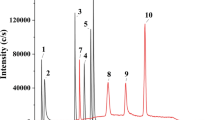Abstract
Recent investigations have shown that arsthinol, a trivalent organoarsenic compound (dithiarsolane), has been active in vitro on leukemia cell lines and offers a better therapeutic index than arsenic trioxide, as estimated by the ratio LD50/IC50. To complete our understanding of its urinary excretion, a sensitive method using liquid chromatography coupled with mass spectrometry (LC-MS) was used. Mice were injected intravenously with a single dose of arsthinol at 0.2 mmol/kg of body weight. The amount of total arsenic in tissues and body fluids was determined by a colorimetric method and urine metabolites were analyzed on a C18 Acclaim PepMap 100 Å column by LC-MS. Our results showed that only three arsenic species (acetarsol, acetarsol oxide and arsthinol) were detected in the first 24-h urine. Overall, this study confirms that the hydrolysis of dithiarsolanes to arsenoxides (i.e. acetarsol oxide) can be followed by an oxidation in arsonic acids (i.e. acetarsol). All these compounds are excreted in the urine.










Similar content being viewed by others
References
Ajana I et al (2009) Arsthinol nanosuspensions: pharmacokinetics and antileukemic activity on NB4 promyelocytic leukemia cells. J Pharm Pharmacol 61:1295–1301
Ben Zirar S et al (2007) Pharmacokinetics and tissue distribution of the antileukaemic organoarsenicals arsthinol and melarsoprol in mice. J Organomet Chem 692:1348–1352
Berger BJ, Fairlamb AH (1994) Properties of melarsamine hydrochloride (Cymelarsan) in aqueous solution. Antimicrob Agents Chemother 38:1298–1302
Cristau B et al (1972) Voies et cinétiques d’élimination de l’arsenic chez le rat après administration de médicaments organoarséniés––II. Etude du mélarsoprol et du mélarsonyl potassique. Med Trop (Mars) 32:275–283
Cristau B et al (1973) Elimination biliaire chez le rat de quelques médicaments organoarseniés. J Pharmacol 4:199–207
Cristau B et al (1975) Voies et cinétiques d’excrétion de l’arsenic chez le Cobaye après injection de divers médicaments organo-arséniés. Ann Pharm Fr 33:577–589
Devesa V et al (2004) Comprehensive analysis of arsenic metabolites by pH-specific hydride generation atomic absorption spectrometry. J Anal At Spectrom 19:1460–1467
Elliot SC, Loper BR (1974) Improved absorption tube for arsenic determinations. Anal Chem 46:2256–2257
Forkner C, Scott T (1931) Arsenic as a therapeutic agent in chronic myelogenous leukemia. J Am Med Assoc 97:3–5
Gibaud S et al (2006) (2-Phenyl-[1, 3, 2] dithiarsolan-4-yl)-methanol derivatives show in vitro antileukemic activity. J Organomet Chem 691:1081–1084
Goldman L et al (1956) Arsthinol (Balarsen) in dermatology. Dermatologica 113:369–374
Gregus Z, Gyurasics A (2000) Role of glutathione in the biliary excretion of the arsenical drugs trimelarsan and melarsoprol. Biochem Pharmacol 59:1375–1385
Harrison R (2002) Structure and function of xanthine oxidoreductase: where are we now? Free Radic Biol Med 33:774–797
Hughes MF et al (2003) Accumulation and metabolism of arsenic in mice after repeated oral administration of arsenate. Toxicol Appl Pharmacol 191:202–210
Most H et al (1954) Arsthinol (Balarsen), a new trivalent arsenical for the treatment of intestinal amebiasis and other intestinal protozoa. Am J Trop Med Hyg 3:262–265
Pick E, Keisari Y (1980) A simple colorimetric method for the measurement of hydrogen peroxide produced by cells in culture. J Immunol Methods 38:161–170
Shen ZX et al (1997) Use of arsenic trioxide (As2O3) in the treatment of acute promyelocytic leukemia (APL): II. Clinical efficacy and pharmacokinetics in relapsed patients. Blood 89:3354–3360
Waxman S, Anderson KC (2001) History of the development of arsenic derivatives in cancer therapy. Oncologist 6:3–10
Acknowledgments
The authors thank the « Service commun de spectrométrie de masse » de l’Université Henri Poincaré, Faculté des Sciences et Techniques, 54 506 Vandœuvre lès Nancy.
Author information
Authors and Affiliations
Corresponding author
Rights and permissions
About this article
Cite this article
Ajana, I., Astier, A. & Gibaud, S. Speciation of arsenic in urine following intravenous administration of arsthinol in mice. Eur J Drug Metab Pharmacokinet 35, 59–65 (2010). https://doi.org/10.1007/s13318-010-0009-6
Received:
Accepted:
Published:
Issue Date:
DOI: https://doi.org/10.1007/s13318-010-0009-6




